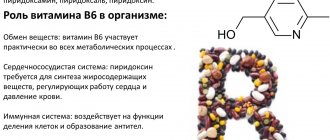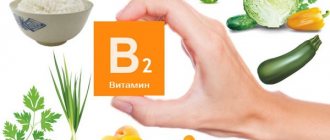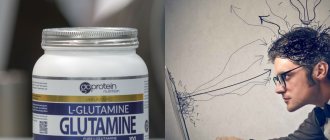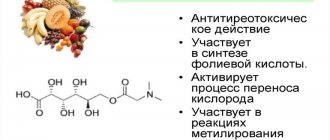© Bildgigant — stock.adobe.com
Share:
We all know about the existence of vitamin B12, but few people are aware that the line of vitamins in this group has continued, and there is an element called B13. It cannot be unambiguously classified as a complete vitamin, but, nevertheless, it has properties that are important for the body.
Opening
In 1904, while synthesizing substances found in fresh cow's milk, two scientists discovered the presence of a previously unknown element with anabolic properties. Subsequent studies of this substance showed its presence in the milk of all mammals, including humans. The discovered substance was named “orotic acid”.
And only almost 50 years after its description, scientists established a connection between orotic acid and the vitamins of the group, recognizing their unity in the molecular structure and principles of action; by that time, 12 vitamins of this group had already been discovered, so the newly discovered element received the serial number 13.
Sources of acid
Let's look at where vitamin B13 is found.
It is unlikely that you will be able to find orotic acid in foods in its pure form. But various salts are found quite often - including calcium, potassium and magnesium. After they enter the blood during absorption, they turn into orotic acid.
What foods contain vitamin B13:
- among animal products, acid can be obtained from liver and dairy foods, including horse milk, cheese, curdled milk and kefir;
- Among plant foods, the content of the required substance differs primarily in yeast, as well as root vegetables;
- Infants can easily obtain this vitamin from their mother's breast milk.
Interestingly, unlike the vast majority of any other vitamins, B13 will remain in food, regardless of the power of heat treatment.
Characteristics
Orotic acid does not belong to the group of vitamins; it is a vitamin-like substance, as it is independently synthesized in the intestines from potassium, magnesium, and calcium supplied with food. In its pure form, orotic acid is a white crystalline powder, which is practically insoluble in water and other types of liquid, and is also destroyed when exposed to light rays.
Vitamin B13 acts as an intermediate product of the process of biological synthesis of nucleotides, which is characteristic of all living organisms.
© iv_design — stock.adobe.com
Indications and contraindications
Uracylcarboxylic acid is used for the prevention and treatment of the following diseases:
- stomach and duodenal ulcers;
- viral hepatitis;
- muscular dystrophy;
- anemia;
- Botkin's disease, biliary tract diseases;
- nephropathy;
- dermatoses, psoriasis, ichthyosis, eczema, neurodermatitis;
- atherosclerosis;
- liver diseases (hepatitis, hepatosis);
- chronic heart failure, coronary heart disease, myocardial infarction, angina pectoris, myocardial dystrophy, arrhythmia (orotic acid improves scarring);
- spastic conditions, including vasospasm;
- nutritional or nutritional-infectious dystrophy, hereditary galactosemia in children;
- hyperlipidemia.
Today, orotic acid is used in the treatment of gout because it suppresses the formation of uric acid.
Indications for additional use of vitamin B13:
- tendency to miscarriages;
- avitaminosis;
- poor diet for meat and dairy products;
- to stimulate anabolic processes;
- postoperative period;
- diseases of the gastrointestinal tract, as a result of which the absorption of the compound deteriorates;
- excessive physical activity;
- period of convalescence.
Contraindications to the use of vitamin compounds:
- hypersensitivity to the substance (intolerance);
- acute or chronic liver damage (cirrhosis with ascites);
- renal failure;
- nephrourolithiasis.
During pregnancy and breastfeeding, you should consult your doctor before taking vitamin B13.
Benefits for the body
Orotic acid is required for many vital processes:
- Takes part in the process of photolipid synthesis, which leads to the strengthening of the cell membrane.
- Activates the synthesis of nucleic acids, which play an important role in the growth process of the body.
- Increases the production of red and white blood cells, improving their quality.
- It has an anabolic effect, which consists of a gradual increase in muscle mass due to the activation of protein synthesis.
- Improves the quality of reproductive function.
- Reduces cholesterol levels, preventing its deposition on the walls of blood vessels.
- Promotes the production of hemoglobin and bilirubin.
- Reduces the amount of uric acid produced.
- Protects the liver from obesity.
- Promotes the breakdown and excretion of glucose.
- Reduces the risk of premature aging.
The role of orotic acid in cosmetology
Vitamin B13 is actively used in cosmetology. Acid restores protein synthesis and normalizes skin metabolic processes. Orotic acid is included in facial cosmetics, which fights aging processes - is effective for aging skin. In cosmetology, the component helps smooth out wrinkles due to:
- Activation of metabolic cellular processes.
- Improved protein synthesis.
- Normalization of water balance.
Attention! In cosmetology, vitamin B13 increases the production of its own hyaluronic acid - an essential substance that helps moisturize and smooth the skin.
In cosmetology, the product is valued for its rejuvenating effect. Promotes the synthesis of collagen, hyaluronic acid, elastin, dexopanthenol. If there is a deficiency, it leads to premature aging, rapid fading and the formation of facial wrinkles. In cosmetology, orotic acid is added to creams, serums, therapeutic and anti-aging masks. Cosmetics have a beneficial effect on dry skin:
- Improves the condition of the body.
- Protect from wind, frost, ultraviolet radiation.
Depending on the manufacturer, brand and purpose, the cream is applied a certain number of times a day. It can be compatible with makeup - decorative cosmetics are applied to it. The foundation is absorbed well without leaving a greasy sheen.
In cosmetology, creams with orotic acid treat peeling in trophic ulcers, psoriasis, and are effective against neurodermatitis. Anti-aging complexes are recommended for use after 30 years. Until this period of a girl’s life, her skin independently copes with the synthesis of collagen, hyaluronic acid and other substances that are responsible for the elasticity of the skin. There are universal cosmetic preparations and those created for a specific skin type.
Cosmetic creams with orotic acid may contain: olive oil, essential oils, and beeswax. The preparations give elasticity to the skin and make it smooth.
In addition to cosmetology, vitamin B13 is involved in the synthesis of vitamin B9, which is responsible for the production of new epidermal cells. The component helps the body fight fatigue and depression. This occurs due to the metabolism of cyanocobalamin - the “red vitamin”. In addition, orotic acid is an anabolic steroid that is often used by athletes to gain muscle mass.
Face masks
In pharmacies, vitamin B13 is sold under the name: Magnesium Orotate and Potassium Orotate. The substance is added to day or night cream and used daily. Magnesium Orotate is a drug for cosmetology, presented in powder form. Potassium Orotate is a medicinal version of the acid in tablets.
You don’t have to buy a rejuvenating face mask in a store. It is made at home. It requires components:
- honey;
- milk;
- Magnesium Orotate powder.
The components need to be mixed, allow the powder to dissolve, and apply the mask for 15 minutes. Rinse with water and apply face cream. Girls over 30 years old undergo the procedure 2 times a week.
For hair
Magnesium Orotate is used in cosmetology for hair growth. Due to its anabolic effect, the drug is able to stimulate the growth of all cells in the human body. This is actively used by those who need to strengthen the hair follicle and activate its growth. Vitamin B13 is added to hair masks. This can be a cosmetic product purchased in a store or a mask created with your own hands. For this you need:
- milk;
- honey;
- almond oil;
- Magnesium Orotate.
We recommend reading: Dietary supplements with hyaluronic acid and collagen
The components need to be mixed, applied to the scalp, and rubbed intensively into the hair roots. To enhance the effect, wrap your head in a terry towel and leave for half an hour. After time, wash off the mixture with shampoo. The cosmetic procedure is carried out once a month. This is a strengthening mask that activates dormant hair follicles, as a result of which they will fall out less and grow faster.
Indications for use
Vitamin B13 is used as an auxiliary source in the complex therapy of various diseases:
- Heart attack, angina and other diseases of the cardiovascular system.
- Dermatitis, dermatoses, skin rashes.
- Liver diseases.
- Atherosclerosis.
- Muscle dystrophy.
- Motor dysfunction.
- Anemia.
- Gout.
Orotic acid is taken during the recovery period after long-term illnesses, as well as during regular sports training. It increases appetite, maintains the health of the fetus during pregnancy when indicated by a doctor.
The importance of vitamin B13 for the human body
Let's look at what orotic acid affects:
- Exchange processes. The vitamin-like compound is involved in the synthesis of pyrimidine nucleotides in the liver. The beneficial effect of the substance on enzyme activity, nitrogen metabolism and protein translation is explained by its participation in the metabolism of nucleic acids. In addition, vitamin B13 is associated with the synthesis of lecithin, phospholipids, bilirubin, stimulating the production of enzymes for carbohydrate metabolism.
- The process of growth. As a result of experiments on animals, scientists came to the conclusion that the compound enhances cell development. The insufficiency of the animal protein factor (as orotic acid was originally called) in the diet of experimental animals led to the fact that females began to produce inferior offspring, especially of the second generation. The young individuals that were born grew poorly and died en masse, in particular during the lactation period. Adding vitamin B13 to the daily menu helped normalize the growth of animals, as well as increase the survival rate of offspring.
- Enzymatic activity. In order to determine the connection between uracilcarboxylic acid and cyanocobalamin, an experiment was conducted on rats at the end of the 20th century, which showed that with B12 deficiency, liver enzymatic activity decreases (glucose-6-phosphatase, cytochrome oxidase, transmethylase, xanthine oxidase) and cell growth is significantly reduced. And when the vitamin enters the body of experimental subjects, the production of protein molecules is normalized. In the process of studying orotic acid, it turned out that it enhances the enzymatic activity of amino acids. Thus, in rats on a diet high in galactose, the production of organic compounds decreased by more than 2 times.
- Pathological condition of the liver. As a result of numerous studies, the Schwietzer scientist found that the vitamin-like substance B13 inhibits the development of toxic gland disease, the clinical picture of which resembles cirrhosis. The progression of the disease is caused by heliotropin and thioazetamide. When orotic acid is administered, the amount of purines in the body increases, which facilitates the process of building nucleic acids. In addition, the compound slows down fatty infiltration of the liver, enhances the secretion of bile and accelerates the process of regeneration of hepatocytes.
- Radiation intoxication. To determine how vitamin b13 affects living organisms, a group of scientists conducted an experiment on animals. The experimental animals were divided into 2 categories. For 10 days, the potassium salt of uracilcarboxylic acid was introduced into the diet of the first group at the rate of 100 milligrams of the substance per kilogram of body weight, the second group did not receive this nutrient and served as a control. After completion of the experiment, the animals were subjected to intense irradiation (2000 gray). In the group that consumed the compound, survival time was 119 hours, in the control group - 4 hours 20 minutes. Thus, regular use of orotic acid during radiation intoxication in prophylactic doses extended the life of the experimental subjects by 16 days. The results of the experiment indicate that the vitamin-like substance can be used as a protective agent against ionizing radiation.
In addition to the indicated properties, uracilcarboxylic acid performs the following functions in the human body:
- prevents narrowing of the lumen of blood vessels, the appearance of atherosclerotic plaques and, as a consequence, the development of atherosclerosis;
- participates in the production of bilirubin, adenosine triphosphate, glucose utilization, regulation of lipid metabolism;
- promotes the proper course of anabolic processes, stimulates muscle growth (ribonucleic acid synthesis);
- has a positive effect on the development of the embryo during pregnancy;
- improves myocardial contraction, reproductive function;
- prevents premature aging;
- has hypouricemic properties;
- normalizes metabolic processes in the skin, which is why orotic acid is often used in cosmetics intended for aging skin;
- activates hematopoiesis (formation of red blood cells, leukocytes), stimulates erythropoiesis after blood loss, increases the phagocytic ability of “white cells”, reduces the risk of developing anemia;
- eliminates skin diseases in children.
The main effect of orotic acid is to participate in the exchange of constituent particles of DNA and RNA - pyrimidine nucleotides. Thus, the compound, like folic acid and cyanocobalamin, is necessary for full growth and cell division. In addition, B13 improves the absorption of folate.
Body needs (instructions for use)
Vitamin B13 deficiency in the body can be determined using a vitamin test. As a rule, if everything is in order, it is synthesized in sufficient quantities. But with intense loads, it is consumed much faster and often requires additional intake.
The daily need for orotic acid depends on various factors: the person’s condition, age, level of physical activity. Scientists have derived an average that determines the daily amount of acid.
| Category | Daily requirement, (g) |
| Children over one year old | 0,5 – 1,5 |
| Children under one year old | 0,25 – 0,5 |
| Adults (over 21 years old) | 0,5 – 2 |
| Pregnant and lactating women | 3 |
Orotic acid in medicine
The benefits of orotic acid were first proven in the early 20th century. Today it is actively used not only in cosmetology, but also in medicine. There are real cases in history when the drug helped children aged 6-12 months with skin diseases: ichthyosis, eczema, psoriasis, neurodermatitis. The medical form of the substance is Potassium Orotate - tablets and Magnesium Orotate - powder.
Indications for taking the drug:
- Liver diseases.
- Orotic acid is used to treat leg cramps.
- Botkin's disease.
- Heart failure.
- Postoperative period.
- Diseases of the stomach, gastrointestinal tract.
- Viral hepatitis.
With the help of orotic acid, the body better tolerates taking medications: resoquine, steroid hormones, antibiotics, delagil, sulfonamide.
Orotic acid is effective against gout - numerous inflammatory processes in joint and kidney tissues. In case of illness, it stimulates protein metabolism, protects internal organs from toxic substances, and relieves pain. Metabolic effects occur against the background of the disease. This occurs due to the excretion of uric acid compounds by the kidneys. Orotic acid accelerates the elimination of toxic breakdown products and limits the concentration of urea in the bloodstream.
In addition to their benefits, substances can cause harm to the human body. Contraindications, precautions:
- Nephrourolithiasis.
- Kidney failure.
- Allergy.
- Acute liver lesions complicated by ascites.
- Hypersensitivity
If there are prerequisites for the above diseases, you should refrain from taking the drug so as not to harm your health.
Advice! It is recommended to consult a doctor before taking the drug.
Content in food
Vitamin B13 can be synthesized in the intestines, supplemented by the amount that comes with food.
© alfaolga — stock.adobe.com
| Products* | Vitamin B13 content (g) |
| Brewer's yeast | 1,1 – 1,6 |
| Animal liver | 1,6 – 2,1 |
| Sheep milk | 0,3 |
| Cow's milk | 0,1 |
| Natural fermented milk products; | Less than 0.08 g |
| Beetroot and carrots | Less than 0.8 |
*Source – Wikipedia
Vitamin B13 deficiency
With a lack of vitamin B13, the body suffers greatly from the consequences of irreversible disturbances in biochemical processes. First of all, there is a significant deterioration in the course of dermatological diseases. Despite all this, no specific or pathological conditions develop as a result of a lack of vitamin B13.
It is necessary to take into account the fact that the deficiency of vitamin B13 can be partially compensated for by other B vitamins, and some restructuring of metabolic processes and mechanisms will occur.
Review of drugs
Potassium orotate - release form - tablets 0.5 g. For children, it is produced in granules for the preparation of syrup or in tablets 0.1 g. Replenishes the deficiency of orotic acid, stimulates metabolism, has a diuretic effect and increases appetite.
The most common form of release of orotic acid is tablets.
Magnesium orotate is available in powder form and has antispasmodic and antiarrhythmic effects. Replenishes the lack of magnesium and orotic acid in the body. Acts as a cardioprotector. Prescribed for angina pectoris, atherosclerosis, alcoholism to relieve withdrawal symptoms.
Analogs of Magnesium orotate are Orocamage and Magnerot.










